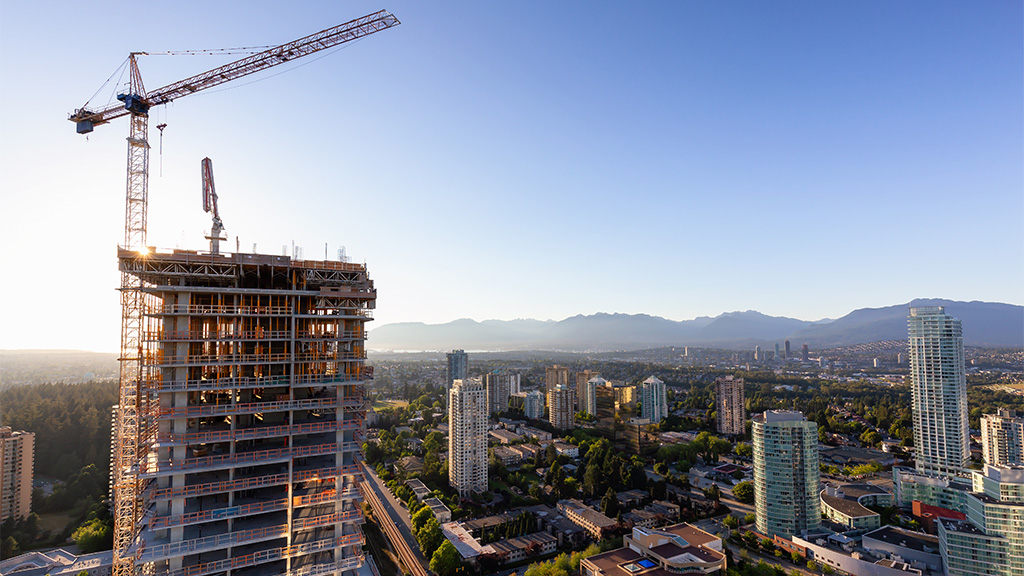Some stakeholders say the Government of British Columbia is on the right track to speed up home deliveries, but measures are coming roughly a decade later than needed.
“The provincial government has actually been extremely aggressive in addressing housing supply. We’ve seen a string of announcements since just before Christmas and extending right into early last week that speak directly to this process,” said Ron Rapp, CEO of the Homebuilders Association Vancouver (HAVAN).
In a recent report, the British Columbia Real Estate Association (BCREA) found increased immigration targets are outpacing the projected housing supply and driving up costs.
Brendon Ogmundson, chief economist with the BCREA and author of the report, said the province needs to maintain a record level of homebuilding over five years in order to keep the current housing market and prices level.
Ogmundson told the JOC the province needs to build at least 43,000 homes every year for the next five years. But he pointed out that keeping completions at this sustained record-breaking level would, at best, maintain the current status quo. He said in order to actually improve affordability, B.C. would need to see closer to 60,000 units completed ever year.
“So, to bend the curve on affordability we would definitely need a lot more than 45,000 completions every year. But, we’ve never had a five-year period of completing that many units. It would be unprecedented,” Ogmundson said.
But B.C. only completed little more than 38,000 units in 2022 and trends show that number is slowing down, according to the Canada Mortgage and Housing Corporation.
There are of course roadblocks to increasing housing supply and the industry in the province is pretty much working at its capacity, Rapp said. However, strides are being made in the right direction.
One of the main difficulties that builders traditionally face when trying to get more housing built is a disconnect between multiple levels of government. Federal or provincial policies could be challenged on a municipal level, for example.
But Rapp said that’s not a major problem right now in B.C.
“For the first time in a very long time we’ve got almost perfect alignment between all levels of government in terms of driving a higher volume of housing supply across all markets,” said Rapp.
But a shortage of labour is an integral problem impeding the speed of housing deliveries and has led the industry into a catch-22 situation: we can’t build more houses because there is a labour shortage so more immigration is needed to increase labour, which results in more housing demand.
“So, now what do we do?” Rapp said.
While Rapp was quite supportive of provincial measures to get more houses built, he said the unfortunate truth is they won’t drastically change the climate for builders anytime soon.
“We have seen a significant degree of intervention on the part of the province and on the part of the feds to try to expedite the production of homes, but that’s going to take some time to sift through the system,” Rapp said.
“The disconnect, in some respects, is that we’re working on this a bit a little bit too late.”
Ogmundson highlighted recent policy from the province to create a one-stop-shop permitting system and blanket rezoning in Vancouver as good policy that “should have been done 10 years ago.”
Rapp said cohesiveness across governments needs to be ensured to speed up building. This means reducing development charges, speeding up permitting, regulating community amenity contributions and “realizing this is an all-hands-on-deck situation.”
Ogmundson pointed out the private sector carries some of the blame.
“The private sector today needs to get more productive. They build things the same way they have for decades. Maybe we need more modular housing. Maybe we need some technological improvements.” he said.
Ogmundson said private sector investments into tech like off-site fabrication could help increase the rate of supply.
That builds into another way the private sector can address supply shortages which is not an easy sell: overbuilding.
“The private sector is going to react to market conditions and economic factors and that means we don’t get what we really need, which is too much supply. We need to overbuild and developers aren’t stupid,” Ogmundson said.
“We need that but it’s almost impossible to tell the private sector to build units at a loss.”
He said a solution to that is by having the government offer financial incentives to overbuild and by having the government invest even more in affordable housing builds.
“But it’s tough because ultimately, the market is going to decide how much gets built.”
Rapp said it comes down to leadership and the heads of government need to step up and get the incentives rolling especially when dealing with municipalities who are resistant to high level policy.
“It’s appropriate to show leadership and provide the carrot, if you will, to entice the entire continuum to get on board and to move things forward,” said Rapp.
“And that includes industry. It’s incumbent on everybody to put forward their best effort. The province is setting the stage.”











Recent Comments
comments for this post are closed